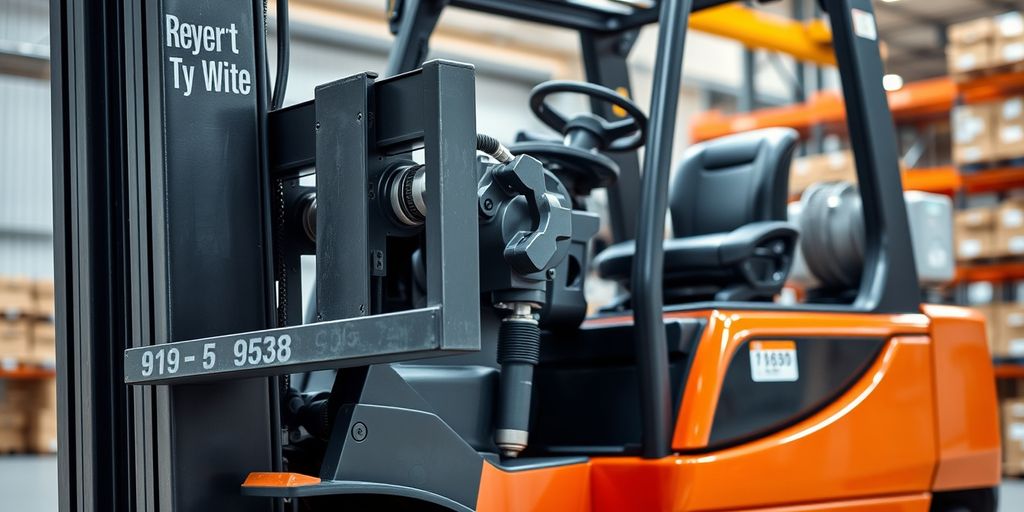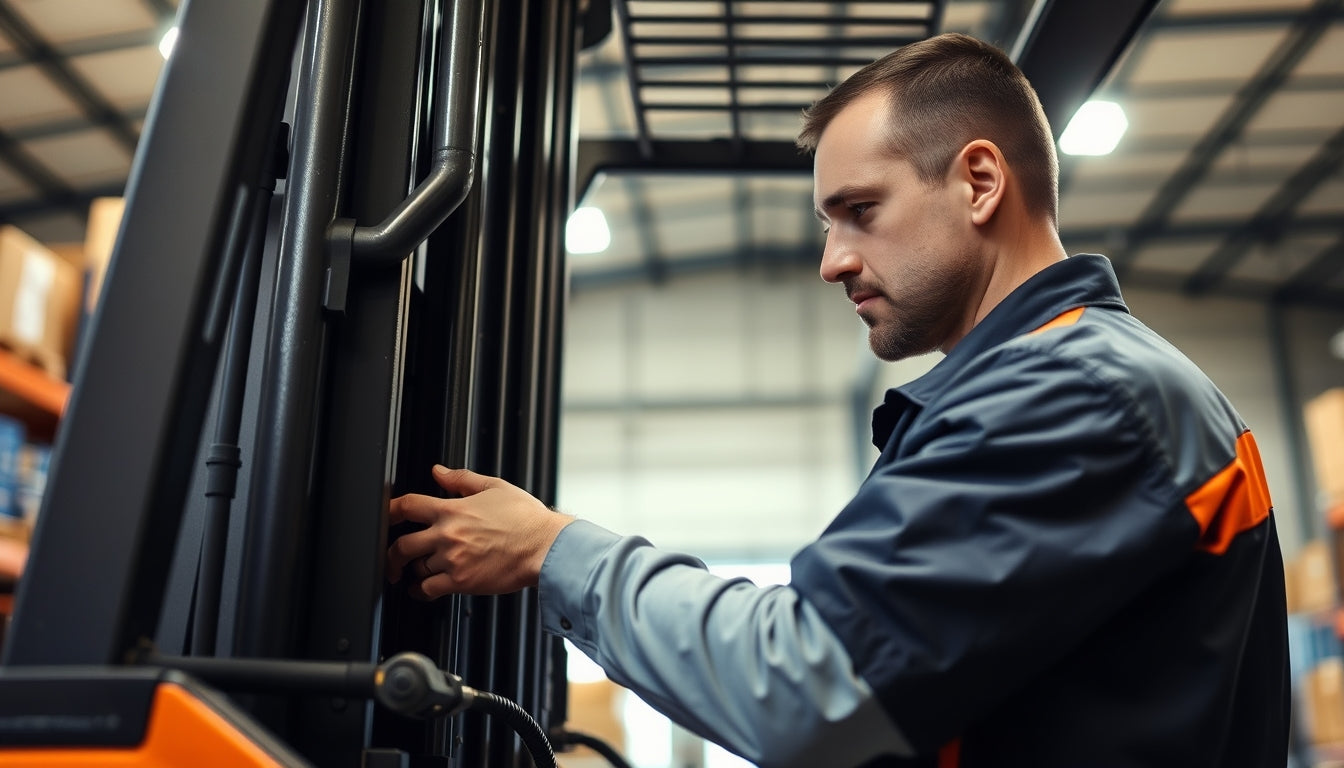Innovaciones en sistemas hidráulicos para montacargas: mejora del rendimiento y la confiabilidad — overview
Los sistemas hidráulicos son el corazón de los montacargas y potencian su capacidad para levantar y mover cargas pesadas. Con los avances tecnológicos, estos sistemas se han vuelto más eficientes y confiables. Este artículo explora las últimas innovaciones en sistemas hidráulicos para montacargas y cómo mejoran el rendimiento y la seguridad.
Conclusiones clave
- Los sistemas hidráulicos son cruciales para las capacidades de elevación y movimiento de los montacargas.
- Avances como los sistemas de control electrónico y los sensores inteligentes mejoran el rendimiento y la seguridad.
- El mantenimiento regular, incluidas revisiones de fluidos y reemplazo de piezas, es esencial para un funcionamiento óptimo.
- La capacitación adecuada del operador sobre controles hidráulicos y prácticas de seguridad aumenta la eficiencia y reduce el desgaste.
- Las tendencias emergentes, como las carretillas elevadoras autónomas y las soluciones hidráulicas sostenibles, están dando forma al futuro de la industria.
Avances en sistemas de control hidráulico

Sistemas de Control Electrónico
La integración de sistemas de control electrónico en la tecnología hidráulica ha revolucionado la industria. Estos sistemas ofrecen un control preciso sobre las funciones hidráulicas, mejorando tanto el rendimiento como la seguridad. Al utilizar software, los operadores ahora pueden ajustar los parámetros rápidamente, eliminando la necesidad de cambios de hardware. Esta flexibilidad simplifica el desarrollo y la puesta en marcha de la máquina, lo que facilita la consecución de los resultados deseados.
Integración de Sensores Inteligentes
Los sensores inteligentes se han convertido en un punto de inflexión en los sistemas hidráulicos. Estos sensores proporcionan datos en tiempo real sobre varios parámetros, como presión y temperatura, lo que permite realizar ajustes inmediatos. Esto no solo mejora la eficiencia sino que también ayuda en el mantenimiento predictivo, reduciendo el tiempo de inactividad y extendiendo la vida útil de los componentes hidráulicos.
Válvulas Proporcionales
Las válvulas proporcionales son otro avance significativo en los sistemas de control hidráulico. Estas válvulas permiten un control variable del flujo de fluido hidráulico, ofreciendo un funcionamiento más preciso y suave. Son particularmente útiles en aplicaciones que requieren ajustes finos, como en el manejo de materiales y la automatización industrial.
La integración de estas tecnologías avanzadas ha hecho que los sistemas hidráulicos sean más confiables y eficientes, satisfaciendo las necesidades en constante evolución de diversas industrias.
Estrategias de mantenimiento para sistemas hidráulicos
Inspecciones Programadas
Las inspecciones periódicas son esenciales para mantener los sistemas hidráulicos en óptimas condiciones. Las comprobaciones de rutina ayudan a detectar desgaste, fugas o daños de forma temprana. Inspeccione las mangueras, los accesorios, los sellos y las conexiones para detectar cualquier problema. Preste atención a los niveles de líquido y a la limpieza, y escuche si hay ruidos o vibraciones inusuales durante el funcionamiento.
Revisiones y Reemplazos de Fluidos
El mantenimiento adecuado de los fluidos es fundamental para que los sistemas hidráulicos funcionen bien. Siga las pautas para la selección de fluidos, la viscosidad y los intervalos de cambio. Controle periódicamente la calidad y la limpieza de los fluidos y realice análisis de fluidos para detectar cualquier contaminación o degradación.
Reemplazos Preventivos de Componentes
El reemplazo preventivo de componentes puede ahorrar tiempo y dinero a largo plazo. Inspeccione y reemplace los sellos con regularidad para evitar fugas y garantizar la integridad del sistema. Utilice filtros de alta calidad para mantener el fluido hidráulico limpio y libre de residuos, agua y contaminantes del aire. Reemplace los filtros según sea necesario para mantener una eficiencia de filtración óptima.
Siguiendo estas estrategias de mantenimiento, los operadores pueden garantizar la longevidad y el rendimiento óptimo de sus sistemas hidráulicos. El mantenimiento regular, junto con una gestión adecuada de los fluidos y el control de la contaminación, ayudará a maximizar la eficiencia, minimizar el tiempo de inactividad y ampliar la vida útil del equipo hidráulico.
Capacitación del operador para un rendimiento hidráulico óptimo
Capacitación en Controles Hidráulicos
La capacitación adecuada sobre los controles hidráulicos es esencial para los operadores de montacargas. [Certified training programs](https://onlineoshasafetytraining.com/driving-a-forklift-for-the-first-time/) asegúrese de que los operadores comprendan cómo usar los controles de manera eficaz, lo que ayuda a lograr una temperatura de funcionamiento óptima para el motor y los sistemas hidráulicos. Esta capacitación a menudo incluye práctica y conocimientos teóricos, que cubren varios aspectos de las operaciones hidráulicas.
Consideraciones sobre la Capacidad de Carga
Comprender la capacidad de carga es fundamental para operar de manera segura y eficiente las carretillas elevadoras. Los operadores deben recibir capacitación para reconocer los límites de sus equipos y cómo manipular diferentes cargas. Este conocimiento ayuda a prevenir accidentes y a garantizar que la carretilla elevadora permanezca libre de movimientos durante cambios importantes en la elevación de la carga. Los programas de capacitación suelen incluir pautas sobre cómo distribuir el peso y gestionar la estabilidad de la carga.
Prácticas de Operación Segura
La seguridad es una prioridad absoluta al operar carretillas elevadoras. Los programas de capacitación enfatizan la importancia de prácticas operativas seguras para minimizar los riesgos. Los operadores aprenden sobre los peligros potenciales y cómo evitarlos. Esto incluye comprender la importancia de las comprobaciones periódicas de mantenimiento, el uso adecuado de las funciones de seguridad y el cumplimiento de los protocolos operativos. Las prácticas operativas seguras no sólo protegen al operador sino que también mejoran la confiabilidad general del sistema hidráulico.
La capacitación adecuada del operador garantiza que las funciones hidráulicas se utilicen de manera efectiva, minimizando el desgaste de los componentes y optimizando el consumo de energía.
Componentes hidráulicos clave y sus funciones
Cilindros Hidráulicos
El mecanismo de elevación de un montacargas se basa en cilindros hidráulicos para convertir la presión hidráulica en fuerza mecánica. Estos cilindros, a menudo equipados con un conjunto de pistón y vástago, se extienden o retraen para elevar o bajar las horquillas. El diseño y la calidad de los cilindros hidráulicos afectan significativamente la precisión de elevación y el rendimiento general. Los cilindros de doble efecto, capaces de ejercer fuerza en ambas direcciones, se utilizan comúnmente en carretillas elevadoras para mayor versatilidad.
Sellos y Prevención de Fugas
En el ámbito hidráulico, los sellos actúan como guardianes silenciosos, evitando el escape no deseado de fluido hidráulico y manteniendo la integridad del sistema. Los sistemas hidráulicos de montacargas emplean varios sellos, incluidas juntas tóricas, juntas y sellos de labio, ubicados estratégicamente en juntas y puntos de conexión. La inspección y el reemplazo regulares de estos sellos son esenciales para evitar fugas, que pueden comprometer el rendimiento y provocar reparaciones costosas.
Filtros Hidráulicos
La limpieza es primordial en un sistema hidráulico y los filtros desempeñan un papel crucial en el mantenimiento de la pureza del fluido hidráulico. Los filtros hidráulicos atrapan contaminantes como suciedad, residuos y partículas metálicas, impidiendo que circulen por el sistema y causen daños. El mantenimiento de rutina del filtro es vital para garantizar un rendimiento óptimo y la longevidad de los componentes hidráulicos del montacargas.
Eficiencia e Integración de Sistemas Hidráulicos
Integración de Componentes
La eficiencia de los sistemas hidráulicos de las carretillas elevadoras depende en gran medida de la integración de los componentes. Una integración adecuada garantiza que cada pieza funcione a la perfección con las demás, lo que genera un mejor rendimiento y confiabilidad. Esta integración afecta directamente el rendimiento general de la carretilla elevadora, incluida la velocidad de elevación, la precisión y el consumo de energía.
Optimización del Consumo de Energía
La eficiencia energética es un aspecto clave en el mercado de equipos hidráulicos. Los fabricantes están desarrollando sistemas que minimizan las pérdidas de energía e incorporan tecnologías regenerativas. Estos sistemas de eficiencia energética ayudan a reducir los costos operativos y respaldan los esfuerzos de sostenibilidad. El principal problema de los equipos hidráulicos es su alto consumo de energía, que puede generar mayores costos. Al optimizar el uso de la energía, estos sistemas pueden volverse más rentables y respetuosos con el medio ambiente.
Velocidad y Precisión de Elevación
Los avances en la tecnología hidráulica han permitido lograr mejoras significativas en la velocidad y precisión de elevación. Innovaciones como los sistemas de control electrónico y los sensores inteligentes proporcionan a los operadores un mayor control y monitoreo en tiempo real de las funciones hidráulicas. Estos avances no solo mejoran la eficiencia, sino que también contribuyen a la seguridad y confiabilidad de las operaciones con montacargas.
En el dinámico mundo del manejo de materiales, los montacargas son herramientas indispensables y sus sistemas hidráulicos sirven como motor detrás de sus capacidades de elevación. La combinación de ingeniería de precisión, tecnología avanzada y un mantenimiento meticuloso garantiza que los sistemas hidráulicos de los montacargas funcionen sin problemas, entregando la potencia de bombeo necesaria para elevar las industrias, una carga a la vez.
Tendencias Emergentes en Hidráulica de Montacargas

Montacargas Autónomos
El cambio hacia las carretillas elevadoras autónomas está transformando la industria. Estas máquinas pueden desplazarse por los almacenes con una mínima intervención humana, lo que reduce los accidentes y aumenta la eficiencia . Los módulos de visualización avanzados proporcionan datos en tiempo real, lo que mejora el control y la fiabilidad en entornos complejos.
Soluciones Hidráulicas Sostenibles
Las preocupaciones medioambientales están impulsando la adopción de soluciones hidráulicas sostenibles . Las carretillas elevadoras eléctricas y las pilas de combustible de hidrógeno son cada vez más populares debido a que no generan emisiones y se recargan rápidamente. Este cambio no solo aborda cuestiones medioambientales, sino que también satisface las necesidades operativas de los almacenes modernos.
Integración de IA e IoT
La integración de la IA y la IoT en las carretillas elevadoras está revolucionando la industria. Estas tecnologías permiten el mantenimiento predictivo, la navegación autónoma y la manipulación adaptativa de la carga. Las carretillas elevadoras impulsadas por IA mejoran la eficiencia y la seguridad, lo que las convierte en una tendencia clave en la evolución de la tecnología de las carretillas elevadoras.
Dinámica de Fluidos Hidráulicos
Rol del fluido hidráulico
El fluido hidráulico, a menudo aceite hidráulico, es el elemento vital del sistema hidráulico de una carretilla elevadora. Transmite fuerza, lubrica las piezas móviles y reduce el desgaste. El fluido se presuriza mediante una bomba hidráulica , lo que crea una fuerza que empuja contra las superficies de los cilindros o pistones hidráulicos. Este proceso permite operaciones de elevación precisas y resistentes .
Criterios de Selección de Fluidos
Elegir el fluido hidráulico adecuado es crucial. Debe soportar altas presiones y variaciones de temperatura y, al mismo tiempo, proporcionar una lubricación adecuada. A continuación, se indican algunos factores clave que se deben tener en cuenta:
- Viscosidad: el fluido debe tener el espesor adecuado para fluir fácilmente pero aún así proporcionar suficiente lubricación.
- Rango de temperatura: debe funcionar bien bajo las temperaturas de funcionamiento del montacargas.
- Compatibilidad: El fluido debe ser compatible con los materiales utilizados en el sistema hidráulico.
Componentes Hidráulicos a Medida
La integración de componentes hechos a medida, como mangueras hidráulicas hechas a medida y otras piezas diseñadas con precisión, mejora significativamente la seguridad y eficiencia del sistema. Estas piezas a medida están diseñadas para cumplir con las especificaciones y tolerancias exactas de su maquinaria, lo que garantiza un ajuste perfecto que reduce el riesgo de fugas y fallas mecánicas.
El mantenimiento regular, incluidas revisiones y reemplazos de fluidos, es vital para mantener el sistema hidráulico en condiciones óptimas, garantizando que todos los componentes, ya sean estándar o hechos a medida, funcionen perfectamente juntos.
Conclusión
En el acelerado mundo del manejo de materiales, los montacargas son herramientas esenciales y sus sistemas hidráulicos son el corazón de su desempeño. Innovaciones recientes, como sensores inteligentes y controles electrónicos, han mejorado significativamente la eficiencia y seguridad de estas máquinas. El mantenimiento regular y la capacitación adecuada de los operadores son cruciales para que estos sistemas funcionen sin problemas y de forma segura. A medida que la tecnología continúa avanzando, podemos esperar aún más mejoras en los sistemas hidráulicos, lo que hará que los montacargas sean más confiables y eficientes. Al adoptar estas innovaciones, las empresas pueden garantizar que sus operaciones sigan siendo competitivas y productivas.
Preguntas frecuentes
¿Cuáles son los beneficios de los sistemas de control electrónico en carretillas elevadoras?
Los sistemas de control electrónico mejoran el rendimiento de los montacargas al brindar a los operadores un mejor control y monitoreo en tiempo real de las funciones hidráulicas. Esto conduce a una mayor eficiencia, seguridad y confiabilidad.
¿Con qué frecuencia se debe revisar y reemplazar el fluido hidráulico en los montacargas?
El líquido hidráulico debe revisarse periódicamente y reemplazarse según las recomendaciones del fabricante. Las revisiones periódicas ayudan a mantener un rendimiento óptimo y evitar posibles daños al sistema hidráulico.
¿Por qué es importante la capacitación de los operadores para los sistemas hidráulicos de montacargas?
La formación adecuada del operador garantiza que las funciones hidráulicas se utilicen de forma eficaz, reduciendo el desgaste de los componentes y optimizando el uso de energía. La capacitación también cubre la capacidad de carga y las prácticas operativas seguras, que son cruciales para la seguridad y la eficiencia.
¿Qué papel juegan los cilindros hidráulicos en las carretillas elevadoras?
Los cilindros hidráulicos convierten la presión hidráulica en fuerza mecánica, lo que permite que el montacargas levante y baje cargas. La calidad y el diseño de estos cilindros son vitales para un levantamiento preciso y un rendimiento general.
¿Qué avances se están produciendo en soluciones hidráulicas sostenibles para carretillas elevadoras?
Los avances en soluciones hidráulicas sostenibles incluyen el desarrollo de carretillas elevadoras eléctricas y de pila de combustible de hidrógeno. Estas tecnologías tienen como objetivo reducir las emisiones y mejorar la eficiencia energética, contribuyendo a la sostenibilidad ambiental.
¿Cómo mejoran los sensores inteligentes los sistemas hidráulicos de las carretillas elevadoras?
Los sensores inteligentes proporcionan datos en tiempo real sobre el rendimiento del sistema hidráulico, lo que ayuda a monitorear y ajustar las operaciones para una mayor eficiencia y seguridad. Pueden detectar problemas tempranamente, reduciendo el riesgo de averías y mejorando la fiabilidad general.




Deja un comentario
Este sitio está protegido por hCaptcha y se aplican la Política de privacidad de hCaptcha y los Términos del servicio.